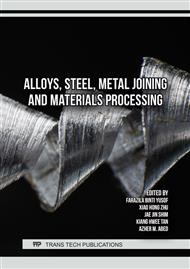p.41
p.51
p.67
p.77
p.87
p.99
p.117
p.131
p.147
A Practical Analysis of Wire Drawing Operation Effects on the Die and Product Behaviors
Abstract:
This study analyse the effects of different wire drawing experimental tests on the die and product properties. Drawing load, temperature, and wear rate are main die factors, that concerned with the interaction effects of drawing speed variation, wire angle alignment and lubrication. For the product, two factors; tensile strength and hardness are taken. A copper wire is drawing from (4.3 mm) into (3.5 mm) diameter with an area reduction of 1.65, 34% ratio.Six dies were employed in various alignments at three different angles (0°, 1°, and 2°), each has two different drawing speeds of (20 mm/min and 40 mm/min). Results show, the highest drawing load and temperature values in die no.5. The effect of using grease on the die wear rate found that the die wear decreases compared to without. But, when using mixed gradients under the same working conditions, the wear rate changed into coating layer on the die surface. The interaction effect of wire alignment on the product strength showing very small when dealing with low or higher speed, but elongation and ductility are significantly reduced with increasing the angle. The wire produced from die no.1, gives the highest micro hardness.
Info:
Periodical:
Pages:
117-130
Citation:
Online since:
July 2024
Keywords:
Price:
Сopyright:
© 2024 Trans Tech Publications Ltd. All Rights Reserved
Share:
Citation:



